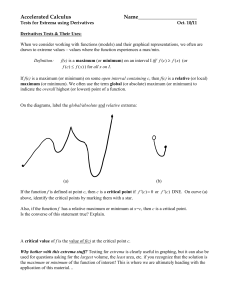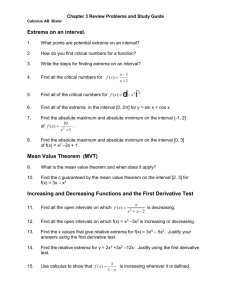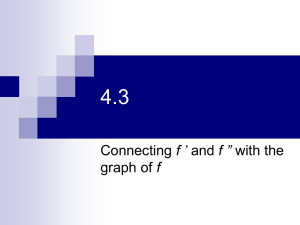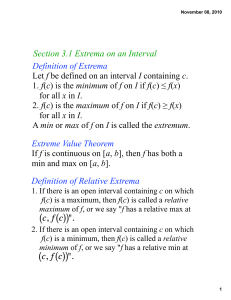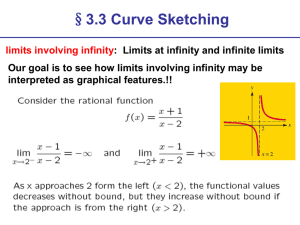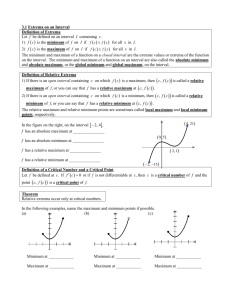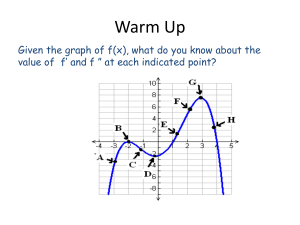MAC 2311 W11 4.1-4.2
advertisement
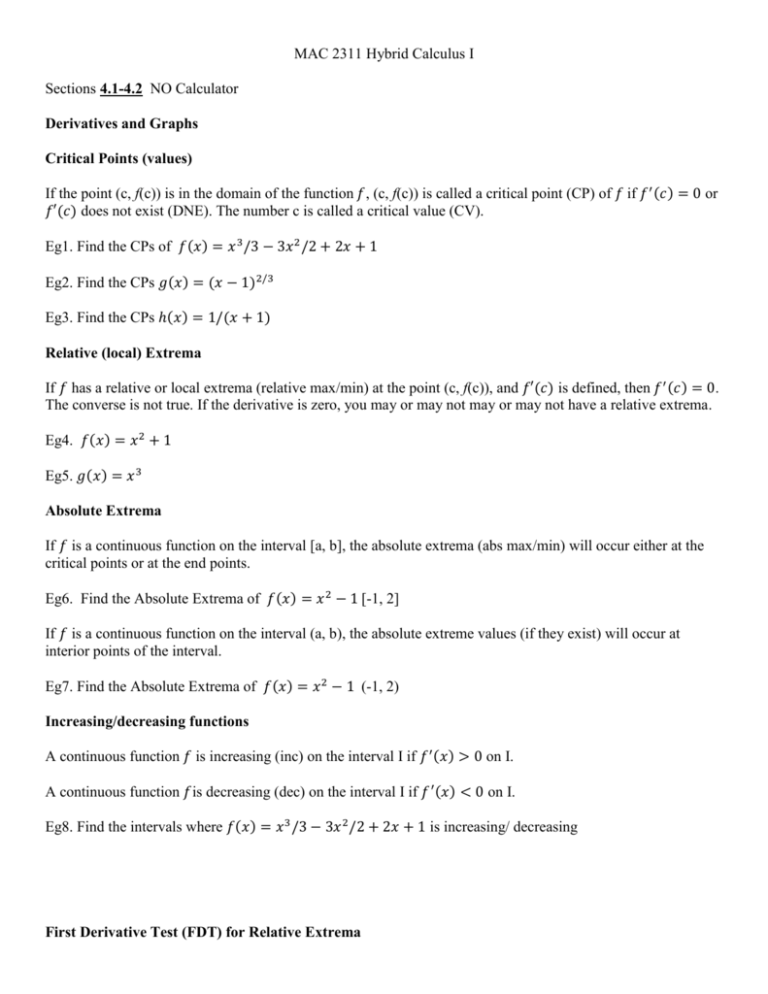
MAC 2311 Hybrid Calculus I Sections 4.1-4.2 NO Calculator Derivatives and Graphs Critical Points (values) If the point (c, f(c)) is in the domain of the function 𝑓, (c, f(c)) is called a critical point (CP) of 𝑓 if 𝑓 ′ (𝑐) = 0 or 𝑓′(𝑐) does not exist (DNE). The number c is called a critical value (CV). Eg1. Find the CPs of 𝑓(𝑥) = 𝑥 3 /3 − 3𝑥 2 /2 + 2𝑥 + 1 Eg2. Find the CPs 𝑔(𝑥) = (𝑥 − 1)2/3 Eg3. Find the CPs ℎ(𝑥) = 1/(𝑥 + 1) Relative (local) Extrema If 𝑓 has a relative or local extrema (relative max/min) at the point (c, f(c)), and 𝑓′(𝑐) is defined, then 𝑓 ′ (𝑐) = 0. The converse is not true. If the derivative is zero, you may or may not may or may not have a relative extrema. Eg4. 𝑓(𝑥) = 𝑥 2 + 1 Eg5. 𝑔(𝑥) = 𝑥 3 Absolute Extrema If 𝑓 is a continuous function on the interval [a, b], the absolute extrema (abs max/min) will occur either at the critical points or at the end points. Eg6. Find the Absolute Extrema of 𝑓(𝑥) = 𝑥 2 − 1 [-1, 2] If 𝑓 is a continuous function on the interval (a, b), the absolute extreme values (if they exist) will occur at interior points of the interval. Eg7. Find the Absolute Extrema of 𝑓(𝑥) = 𝑥 2 − 1 (-1, 2) Increasing/decreasing functions A continuous function 𝑓 is increasing (inc) on the interval I if 𝑓 ′ (𝑥) > 0 on I. A continuous function 𝑓is decreasing (dec) on the interval I if 𝑓 ′ (𝑥) < 0 on I. Eg8. Find the intervals where 𝑓(𝑥) = 𝑥 3 /3 − 3𝑥 2 /2 + 2𝑥 + 1 is increasing/ decreasing First Derivative Test (FDT) for Relative Extrema Suppose 𝑓is differentiable at every point on an Interval I that contains the critical value c (except perhaps at c itself). If 𝑓′ changes sign from positive to negative as x increases through the value c, then 𝑓 is a local maximum at c. If 𝑓′ changes sign from negative to positive as x increases through the value c, then 𝑓 is a local minimum at c. If 𝑓′ does not change sign through c, then 𝑓 has no local extrema at c. Eg9. Use the FDT to find the relative extrema of 𝑓(𝑥) = 𝑥 5 /5 − 3𝑥 4 /4 + 2𝑥 3 /3 + 1 Concavity From the intuitive stand point, an arc of a curve is said to be concave up if it has the shape of a cup and concave down if it has the shape of a cap. If 𝑓′′ (𝑥) > 0 on an open interval I, then the graph of 𝑓 is concave up (CU) on I. If 𝑓′′ (𝑥) < 0 on an open interval I, then the graph of 𝑓 is concave down (CD) on I. Test for Concavity (Inflection Points (IP)) Suppose 𝑓 ′′ (𝑥) exists on the interval I. If 𝑓 ′′ (𝑥) > 0 on I, then 𝑓 is concave up on I. If 𝑓 ′′ (𝑥) < 0 on I, then 𝑓 is concave down on I. If (c, f(c)) is a point on I at which 𝑓 ′′ (𝑥) = 0, and 𝑓 ′′ (𝑥) changes at c (changes concavity), then (c, f(c)) is an inflection point of 𝑓. Notes: If (c, f(c)) is an inflection point of 𝑓, then 𝑓 ′′ (𝑐) = 0. The converse is not true. If 𝑓 ′′ (𝑐) = 0, you may or may not may or may not have an inflection point. Eg10. Find the inflection points of 𝑓(𝑥) = 𝑥 4 Eg11. Find the inflection points of 𝑔(𝑥) = 𝑥 4 /4 − 𝑥 3 Second Derivative Test (SDT) for Relative Extrema Suppose 𝑓 ′′ (𝑥) is continuous on the open interval I containing c with 𝑓 ′ (𝑐) = 0 (at CV) If 𝑓 ′′ (𝑐) > 0 then 𝑓 has a local minimum at c. If 𝑓 ′′ (𝑐) < 0 then 𝑓 has a local maximum at c. If 𝑓 ′′ (𝑐) = 0 then the test fails. If the test fails, the first derivative test must be used to find local extrema. Eg12. Use the SDT to find the relative extrema of 𝑓(𝑥) = 𝑥 5 /5 − 3𝑥 4 /4 + 2𝑥 3 /3 + 1

